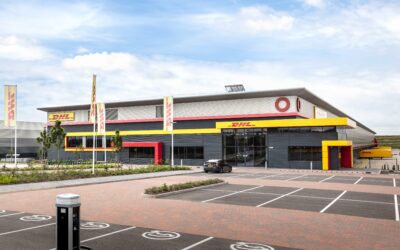Non-machinable or non-conveyable items are the bane of any postal or e-commerce sorting operation. Whether large, heavy, fragile, unstable or oddly shaped, these goods can’t be automatically sorted and instead require inefficient, manual processing. However, with new automation technologies like computer vision and robots, businesses have an opportunity to change this. In the near future, every item could be machinable.
Lars Pruijn, Innovation Director, and Mart Ruijs, Product Manager at Prime Vision explore how computer vision and robotics could make non-machinable items a thing of the past.

Items that don’t fit in
Non-machinable items, often called ‘uglies’ because of the difficulties they pose, can take many different forms – from big TVs, brooms and car tires to large pots of paint. What they all have in common is that, due to their characteristics, they can’t be accommodated in a standard, automated sorting system. As postal services and e-commerce companies invest heavily in fixed infrastructure that is optimized for smaller items, non-machinables present a sizeable problem. They must be identified, separated, and accommodated in a different process.
Traditionally, this has been accomplished manually. Warehouse staff identify non-machinables by eye, then move them by hand to a separate chute or destination. This is time consuming and costly, placing unnecessary strain on workers. Furthermore, a manual approach isn’t fact based, raising the possibility that a non-machinable item might slip through.
Improving the identification and transport of these goods has long been an uphill battle, but computer vision and robotics can provide a solution.

Eyes on the oversized prize
Computer vision technology offers the capability to quickly and accurately identify non-machinable items at the beginning of the sorting process. This eliminates any manual intervention, greatly improving efficiency.
Correct identification of a wide range of items is possible thanks to machine learning. By training artificial intelligence (AI) models using examples from a business’s real-world operations, a computer vision system can not only recognize objects based on dimensions and weight, but other characteristics such as shape, stability, packaging type and more. The more items the system is exposed to, the better it becomes at recognition.
As well as relying on hard data to correctly determine non-machinable items, the system can assist in automatically pre-sorting them to an appropriate chute, conveyor, area or robot – so no unsuitable packages slip through. Furthermore, computer vision seamlessly integrates within the brownfield environment of existing processes too, relying on camera hardware and standalone software.
Ultimately, computer vision speeds up the processing of non-machinable items. Effective pre-sorting means manual intervention is not required, with items that were initially unsuitable for automation now accounted for in a fast, cost-effective process.
Making moves with non-machinable items
With pre-sorting complete, the next question is how to efficiently move non-machinable items to a desired destination? A manual approach is slow and places strain on employees, and by their very nature, these items are unsuitable for fixed conveyor systems.
Robots are famed for enabling incredibly flexible sorting operations, but their versatility in terms of payload provides a unique opportunity to automate the handling and transport of traditionally non-machinable items. The latest robots are highly autonomous, using a combination of computer vision and ranging (LIDAR) to safely navigate a pre-mapped area, picking up and dropping off items to any destination within it. Able to handle anything from a single letter to a 2-metre square parcel weighing well over 30 kg, robots can be equipped to move a wide range of items that would be totally unsuitable for a conveyor system.
With customized systems for gentle loading, transport and unloading (depending on what is being carried) robots can efficiently deliver non-machinable items to the next stage of the sorting process without human intervention. Robots are equally adept working with other installed infrastructure in small- or large-scale operations – allowing almost universal application. Navigation software and a talent for working in tight spaces means that robots carrying large items could even coexist next to others moving smaller ones, uniting sorting operations within a single, highly efficient and flexible ecosystem.

Working together for delivery
Any sortation process is interlinked, and it is at the end of the process where computer vision and robotics can be further integrated to ensure reliable delivery of non-machinable items to customers.
After pre-sorting and transport, non-machinable items need to be placed in chutes or storage areas ready for final dispatch. However, due to their size and awkward shapes, more space needs to be allocated in chutes to accommodate them. Failure to do so risks blockages or items being damaged.
However, by harnessing a computer vision system to check available capacity in each chute, robots can be directed to unload at a destination where room is available, like a game of logistical Tetris. Blockages and damage can be avoided, while providing a healthy buffer for simplified loading into cages, pallets and delivery vehicles.
Making everything machinable
Currently, nearly every sorting operation has a percentage of non-machinable items which represents a reduction in profit. This will not be the case for much longer. The combination of computer vision and robotics promises to end the era of non-machinable items and consign the term to history.
The ability of computer vision to accurately identify problematic goods and the inherent flexibility of robots will soon ensure that every item is machinable. Manual intervention will be a thing of the past, as these parcels and products will be accommodated in an efficient, automatic process that is tailored to their unique requirements. In some cases, the movement of smaller and larger items may be possible in the same areas.
Tantalizingly, this can be achieved in conjunction with existing operational infrastructure, as computer vision and robotics can be integrated with installed hardware and software rather than replacing it. Combined with the inherent flexibility and scalability of both solutions, the entire postal, e-commerce and logistics sector could soon see an end to the era where size and shape mattered.




